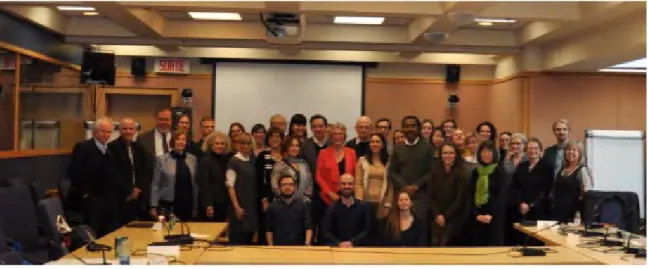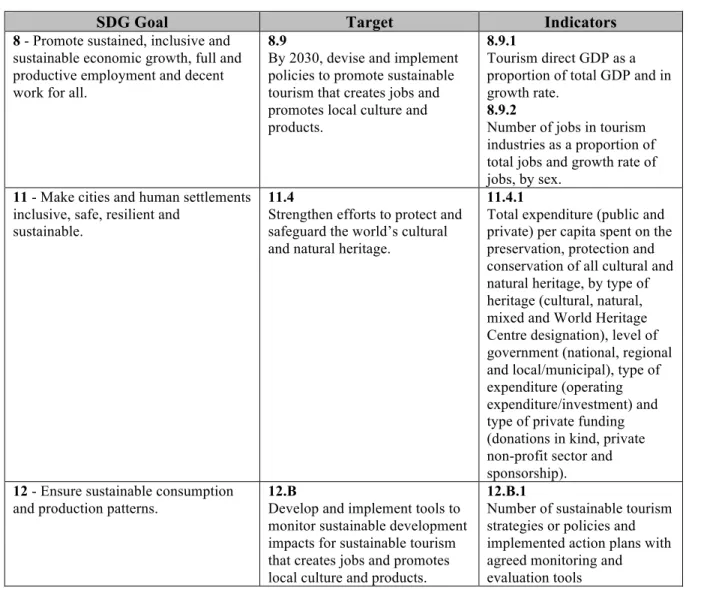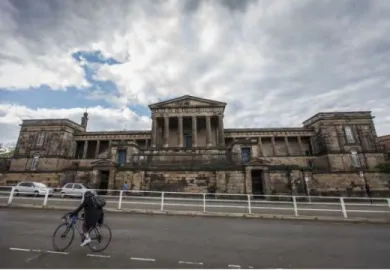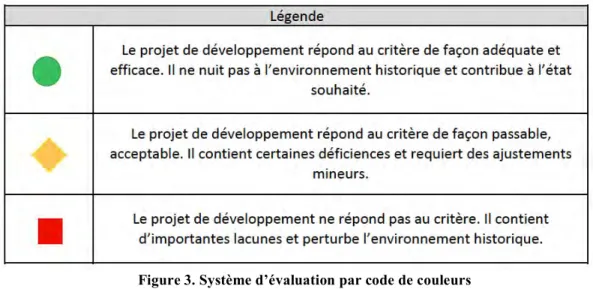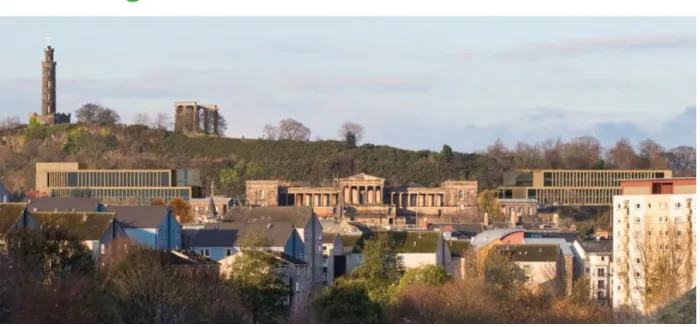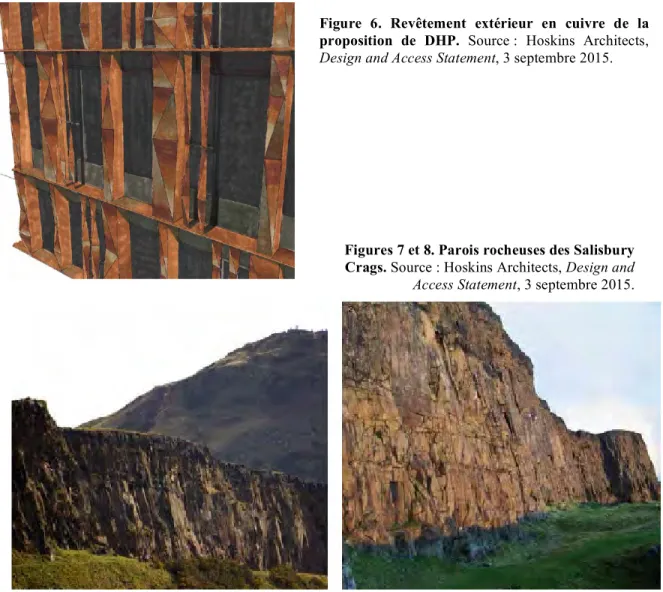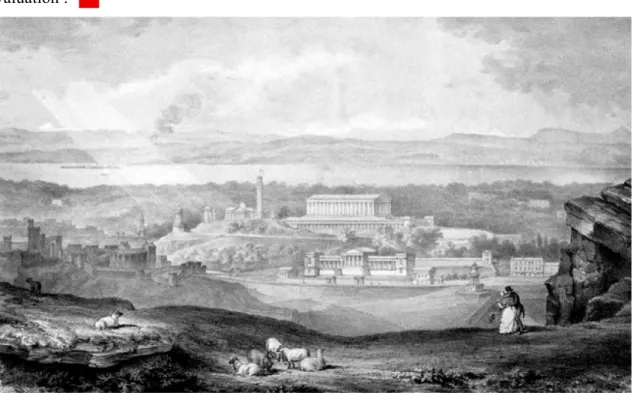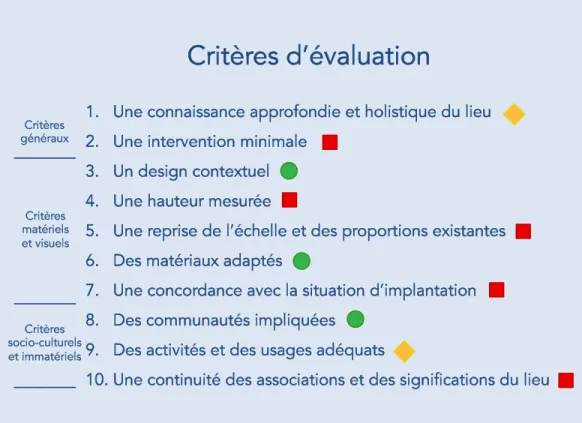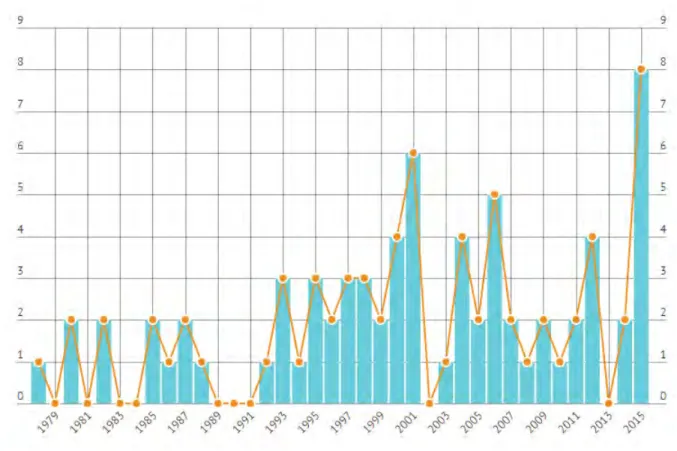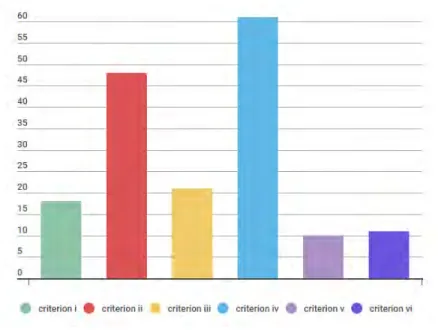PROCÈS-VERBAL/PROCEEDINGS
Édité par/ Edited by : Christina Cameron et/ and Fanny Cardin-Pilon
Table Ronde 2017 organisée par la Chaire de recherche du Canada en patrimoine bâti Faculté de l’aménagement, Université de Montréal
Round Table 2017 organized by the Canada Research Chair on Built Heritage Faculty of Environmental Design, Université de Montréal
15 au 17 mars 2017 / 15-17 March 2017 Montréal, Québec
Comment concilier le tourisme et la conservation des sites du
patrimoine mondial?
Balancing Tourism and Heritage Conservation:
A World Heritage Context
Procès-Verbal/ Proceedings
Édité par/ Edited by : Christina Cameron et/ and Fanny Cardin-Pilon
Table Ronde 2017, organisée par la Chaire de recherche du Canada en patrimoine bâti Faculté de l’aménagement, Université de Montréal Round Table 2017, organized by The Canada Research Chair on Built Heritage Faculty of Environmental Design, Université de Montréal 15 au 17 mars 2017 / 15-17 March 2017 Montréal, Québec
TABLE DES MATIÈRES / TABLE OF CONTENTS
1. INTRODUCTION (FRANÇAIS) ………..…..6
1. INTRODUCTION (ENGLISH)………..…..9
2. PROGRAMME DE LA TABLE RONDE………..12
2. ROUND TABLE PROGRAMME………..18
3. CONFÉRENCE PUBLIQUE/ PUBLIC LECTURE………..….23
Introduction par / by Christina Cameron, professeure / Professor, École d’architecture et titulaire de la Chaire de recherche du Canada en patrimoine bâti, Faculté de l’aménagement, Université de Montréal………...23
Peter Debrine, responsable de projet, programme de tourisme durable, Centre du patrimoine mondial, UNESCO, Paris / Senior Project Officer, Sustainable Tourism Program, World Heritage Centre, UNESCO, Paris Commentaire par/ Comments by Laurent Bourdeau, professeur titulaire, Département de géographie, Titulaire de la Chaire de recherché en partenariat sur l’attractivité et l’innovation en tourisme (Québec – Charlevois), Université Laval, Québec / Professor, Department of Geography and Research Chair, Partenariat sur l’attractivité et l’innovation en tourisme (Québec – Charlevois), Université Laval, Québec 4. PRÉSENTATIONS/ PRESENTATIONS………...25
4.1 Les enjeux de la conciliation entre la conservation du patrimoine et la tourisme/ Tourism and Heritage Conservation : the issues………...25
Christina Cameron, professeure/ Professor, École d’architecture et titulaire de la Chaire de recherche du Canada en patrimoine bâti, Faculté de l’aménagement, Université de Montréal 4.2 Heritage Tourism through the years……….…25
Christopher Young, consultant en Patrimoine, Oxford, Royaume-Uni/ Visiting Professor, University College London and Heritage Consultant, Oxford, United Kingdom 4.3 Towards Sustainable Tourism at World Heritage Sites………..………..26
patrimoine mondial, UNESCO, Paris / Senior Project Officer, Sustainable Tourism Program, World Heritage Centre, UNESCO, Paris
4.4 ICOMOS ICTC International Cultural Tourism Charter……….……27 Susan Millar, presidente, Comité scientifique international de l’ICOMOS sur le tourisme culturel (ICTC) ICOMOS-Royaume-Uni/ President, ICOMOS International Cultural Tourism Committee, ICOMOS-UK, United Kingdom
4.5 Visitor Management Indicators at World Heritage Sites……….…43 Fergus Maclaren, Consultant, MAC-DUFF Tourism-Heritage-Planning, Chelsea, Québec 4.6 Les tendances en matière de tourisme dans les sites du patrimoine mondial…,,,,,,,,,,,,,,,,,,,,..52 Laurent Bourdeau, professeur, Département de géographie et titulaire de la Chaire de recherche en partenariat sur l’attractivité et l’innovation en tourisme (Québec et Charlevoix ), Université Laval, Québec/ Professor, Department of Geography and Research Chair, Partenariat sur l’attractivité et l’innovation en tourisme (Québec, Charlevoix), Université Laval, Québec
4.7 Une méthodologie pour mesurer les impacts de l’infrastructure touristique dans les sites du patrimoine mondial………..53 Adélie De Marre, consultante en patrimoine, Québec/ Heritage Consultant, Québec
4.8 L’approche de Parcs Canada pour concilier la conservation du patrimoine et le tourisme….64 Ellen Bertrand, Directrice des politiques du patrimoine culturel, Direction générale des affaires autochtones et du patrimoine culturel, Parcs Canada, Gatineau/ Director of Cultural Heritage Policies, Indigenous Affairs, Heritage Conservation and Commemoration
Directorate, Parks Canada, Gatineau
4.9 Challenges faced in Heritage Conservation and Sustainable Developments in a tourism- driven Caribbean economy………...71 Geoffrey Ramsey, directeur de la gestion, Environmental Planning Group, Bridgetown, Barbade/ Managing Director, Environmental Planning Group, Bridgetown, Barbados
4.10 Concilier tourisme et habitat: un défi pour le site du patrimoine mondial du Vieux-Québec...90 Odile Roy, Directrice, Architecture et Patrimoine, Service de l’aménagement et
4.11 Facing tourism challenges at Japan’s Mount Fuji WHS……….,..98
Nobuko Inaba, professeur, Études sur le patrimoine mondial, Graduate School of Comprehensive Human Sciences, Université de Tsukuba, Tokyo/ Professor, World Heritage Studies, Graduate School of Comprehensive Human Sciences, University of Tsukuba, Tokyo 4.12 Balancing Tourism and Heritage Conservation at Industrial World Heritage Sites……..…99
Yonca Kösebay Erkan, professeure, Chaire de l’UNESCO en gestion et en promotion des sites du patrimoine mondial: nouveaux medias et engagement communautaire, Université Kadir Has, Istanbul/ Professor, UNESCO Chair in Management and Promotion Of World Heritage Sites: New Media and Community Involvement, Kadir Has University , Istanbul 4.13 Balancing Tourism and Heritage Conservation: experience from cultural landscapes…..110
Nora Mitchell, professeure associée, Université du Vermont, Woodstock/ Adjunct Professor, University of Vermont, Woodstock 5. SESSION DES ÉTUDIANTS / STUDENT SESSION………..126
Les perspectives d’étudiants sur la conciliation entre le tourisme et la conservation des sites du patrimoine mondial : Étude de cas de Venise………....………….127
Student views on the balance between Tourism and World Heritage sites………….……129
6. TEXTES DES/ REPORTS OF THE RAPPORTEURS………..156
Résumé de la table ronde 2017/ Overview of 2017 Round Table………..171
Victoria Dickenson, Consultante, Montréal/ Consultant, Montreal 7. CONCLUSION (FRANÇAIS)………...172
7. CONCLUSION (ENGLISH)………..185
8. LISTE DES PARTICIPANT(E)S……….……..196
8. LIST OF PARTICIPANTS………...…………..203
1. INTRODUCTION (FRANÇAIS)
Christina CameronTitulaire de la Chaire de recherche du Canada en patrimoine bâti Mars 2017
Intitulée Comment concilier le tourisme et la conservation des sites du patrimoine mondial, la 12e Table ronde de Montréal se tiendra du 15 au 17 mars 2017 à Montréal. Elle allie deux thèmes de recherche de la Chaire de recherche du Canada en patrimoine bâti : les méthodologies utilisées pour planifier et gérer les propriétés patrimoniales en se fondant sur les valeurs; et l’influence de la Convention du patrimoine mondial de l’UNESCO sur les pratiques de conservation. La recherche effectuée dans le cadre de la Chaire explore la notion évolutive de patrimoine bâti et les effets de cette mouvance sur les processus de conservation, de développement, d’appropriation, de gestion et
d’utilisation des lieux historiques.
Les annuelles Tables rondes de Montréal offrent une occasion d’apprentissage unique organisée par la Chaire de recherche du Canada en patrimoine bâti de l’Université de Montréal. Chaque année, la titulaire de la Chaire choisit un sujet délicat qui présente un intérêt actuel pour les chercheurs et les praticiens, et elle invite jusqu’à 30 experts canadiens et internationaux à participer à une discussion ouverte qui s’étend sur trois jours. Partageant leurs connaissances de spécialistes en conservation du patrimoine et dans les disciplines connexes, des conférenciers qui travaillent dans des organismes publics, privés, universitaires et non gouvernementaux encadrent le débat. On s’attend à ce que chacun y participe en échangeant ses points de vue avec franchise, fidèle à l’esprit d’une table ronde.
Le choix du sujet de cette 12e Table ronde de Montréal est issu du nombre croissant de sites du patrimoine mondial qui se trouvent menacés par une quantité sans cesse croissante de touristes. Des recherches ont démontré que le statut de patrimoine mondial est un gage d’excellence qui attire le tourisme. De fait, le patrimoine mondial est devenu un levier incontestable pour le développement économique basé sur le tourisme. Selon l'Organisation mondiale du tourisme, les visiteurs
internationaux ont plus que doublé depuis 1995 de 528 millions à 1.2 milliards en 2015. Mais le tourisme n’a pas toujours été une conséquence majeure de l’implantation de la
Convention du patrimoine mondial. Au contraire, au cours des premières années, il ne consistait pas en un enjeu majeur, pas plus que ceux liés à la gestion des sites. Un examen des archives du Comité du patrimoine mondial entre 1977 et 1986 révèle que le tourisme n’est mentionné que 6 fois. Toutefois, au fil du temps, il est devenu un aspect négatif de l’inscription des sites du patrimoine mondial. À la fin des
années 1990, le tourisme de masse est devenu un des principaux motifs de l’obtention de l’inscription sur la Liste et de nos jours, les sites du patrimoine mondial sont de la première importance pour le tourisme culturel. Malgré l’évidence des menaces du tourisme sur les sites du patrimoine mondial, aucun n’a été inscrit sur la Liste du patrimoine mondial en péril et ce, même si la menace sur certains était bien réelle tels que le Sanctuaire historique de Machu Picchu et celui de Venise et sa lagune. L’édition 2017 de la table ronde de Montréal étudie le phénomène de l’impact du tourisme sur la conservation des sites du patrimoine mondial dans le but global d’identifier des compromis potentiels. Il s’agit d’explorer la relation entre l’inscription et l’accroissement des visiteurs, les impacts des
infrastructures de tourisme sur les sites et les zones environnantes, l’impact du tourisme sur la
conservation des sites dans le contexte des changements climatiques ainsi que le potentiel des visiteurs de contribuer aux activités de conservation du patrimoine. La table ronde est conçue pour que l’étude de ce thème s’effectue par des perspectives variées. Peter DeBrine, responsable du Programme du tourisme durable au siège de l'UNESCO à Paris, donnera une conférence publique sur le tourisme durable et la conservation du patrimoine. L'atelier qui s'ensuit examine la question sous diverses perspectives, en commençant par une introduction des enjeux et des dilemmes pour la conservation résultant d’une très grande popularité des sites, suivi d'une session sur les politiques internationales pour le tourisme patrimonial et les lignes directrices. Afin d’approfondir la compréhension des enjeux, les présentations faites pendant la table ronde portent ensuite sur des études universitaires qui analysent l'évolution et l'état actuel du tourisme patrimonial, suivies d'une séance sur les stratégies gouvernementales pour gérer le tourisme aux sites du patrimoine mondial en utilisant des études de cas pour démontrer les meilleures et les pires pratiques. Reconnaissant la nature interdisciplinaire du thème, la session suivante explore la perspective des approches alternatives. L'avant-dernière session est consacrée à la discussion des étudiants sur l'équilibre entre le tourisme et la conservation du patrimoine à l’aide d’un cas précis. La table ronde conclura avec des résumés des rapporteurs ainsi qu’un aperçu des échanges et des enjeux qu’ils ont soulevés.
Les étudiants inscrits à un programme de conservation du patrimoine, y compris ceux qui poursuivent des études supérieures à l’Université de Montréal, à l’Université Carleton à Ottawa, à l’Université Columbia à New York et à l’Université Tsukuba à Tokyo, de même que ceux qui sont inscrits au programme de la Willowbank School of Restoration Arts à Queenston, sont invités à cette expérience d’apprentissage unique. Conformément au mandat éducatif du Programme des chaires de recherche du Canada, les étudiants sont encouragés à participer aux délibérations des tables rondes de
bâti de l’Université de Montréal présentera les résultats de sa recherche, et six étudiants inscrits dans les établissements participants prendront part à une discussion formelle sur l'équilibre entre le tourisme et la conservation du patrimoine sous l’angle d’une étude de cas du site du patrimoine mondial de Venise et sa lagune. Avec une population de 55000 habitants, Venise reçoit 22 millions de visiteurs par an, y compris environ 30000 passagers de navires de croisière. Si tous les étudiants profitent de cette occasion de réseautage, plusieurs jouent aussi le rôle de rapporteurs de séances individuelles. La participation des étudiants répond à l’une des exigences de la Chaire, soit de transmettre des connaissances à la
génération suivante de gardiens du patrimoine, dans la mesure où la réussite à long terme en matière de conservation du patrimoine dépendra des générations futures. Les résultats des précédentes Tables rondes de Montréal sont affichés sur le site web de la Chaire.
En favorisant l’échange sur la recherche, sur l’expérience et sur l’observation, cette rencontre clarifie la théorie et la pratique de conservation. Elle explore différentes facettes permettant de trouver un terrain d’entente. Un tel dialogue aide les chercheurs, les étudiants et les praticiens en conservation du patrimoine à mieux comprendre les approches antérieures et les pratiques actuelles et à fournir une orientation qui permettra de répondre aux besoins du XXIe siècle.
1. INTRODUCTION (ENGLISH)
Christina CameronCanada Research Chair on Built Heritage March 2017
The focus of the 12th Montreal Round Table (2017), Balancing Tourism and Heritage
Conservation: a World Heritage context, held March 15-17, 2017 in Montreal, is aligned with two of the research themes of the Chair: methodologies for values-based planning and management of heritage properties, and secondly the influence of UNESCO’s World Heritage Convention on conservation practice. The Chair’s research program explores the evolving notion of built heritage and the impacts of this evolution on the processes of conservation, development, appropriation, management and use of historic places.
The annual Montreal Round Tables are unique learning opportunities created by the Canada Research Chair on Built Heritage at the Université de Montréal. Each year, the Chair selects a difficult topic of current interest to researchers and practitioners, inviting up to thirty Canadian and international experts with experience in heritage conservation and related disciplines who work in public, private, academic and non-governmental organisations. Over three days, speakers share their specialized
knowledge as a means of framing the debate. In the spirit of a Round Table, each participant is expected to join in a frank exchange of views.
The choice of subject for this 12th edition of the Montreal Round Table stems from the growing number of examples of World Heritage Sites under threat from excessive tourism. Research has proven that World Heritage is a mark of excellence that attracts tourism. As a result of extensive marketing, World Heritage has become a powerful engine for tourism-based economic development. According to the United Nations World Tourism Organisation (UNWTO), international tourism arrivals have more than doubled since 1995, increasing from 528 million to 1.2 billion international arrivals in 2015. But tourism was not always a strong factor in the implementation of the World Heritage
Convention. In the early years, tourism was not an important consideration and management issues were rare. In a review of World Heritage Committee records from 1977 to 1986, tourism is mentioned only six times. Subsequently, it gradually became a negative force for the conservation of World Heritage sites. By the late 1990s, the phenomenon of mass tourism had become one of the prime reasons to seek
damage and over-crowding at some sites, negative impacts can include inappropriate infrastructure projects. Despite the obvious threats to some World Heritage sites, none has been put on the List of World Heritage in Danger as a result of tourism, although several like the Historic Sanctuary of Machu Picchu and Venice and its Lagoon have come close.
The 2017 Montreal Round Table studies the challenge of balancing tourism with heritage conservation imperatives in order to increase understanding and identify possible mitigation strategies. It explores the relationship between World Heritage designation and increased visitation, the impacts of tourism infrastructure on the sites and surrounding areas, the conservation implications of tourism in the context of climate change, as well as the potential for visitors to contribute to heritage conservation activities. The event is structured to examine the question from various perspectives beginning with a public conference on the theme by Peter DeBrine, Senior Project Officer responsible for the World Heritage Sustainable Tourism Program at UNESCO headquarters in Paris. The ensuing workshop examines the issue from various perspectives beginning with an introduction on the issues and an overview of the dilemma of conserving sites at highly popular World Heritage sites, followed by a session on international policies and guidance for heritage tourism. To deepen an understanding of the issue, presentations then focus on scholarly studies that analyse the evolution and current state of heritage tourism, followed by a session on government strategies to manage tourism at World Heritage sites illustrated by case studies to demonstrate best and worst practices in the field. In recognition of the interdisciplinary nature of the theme, the next session explores the perspective of other approaches. The penultimate session is devoted to hearing student views on balancing tourism and heritage conservation through consideration of a case study. The Round Table concludes with reports from the rapporteurs, an overview presentation and general discussion of the issues raised.
Students in heritage conservation studies are invited to this unique learning experience, including participants from graduate programs at the Université de Montréal, Carleton University in Ottawa, Columbia University in New York and Tsukuba University in Tokyo, as well as the diploma program at Willowbank School of Restoration Arts in Queenston. In line with the educational mandate of the Canada Research Chairs program, students are encouraged to participate in the deliberations of the Montreal Round Tables. In 2017, a recent graduate of the Master’s program in the Conservation of Built Heritage at the Université de Montréal will present her research findings while six students from the participating institutions will take part in a formal discussion on balancing tourism and heritage conservation through the lens of Venice and its Lagoon World Heritage site. With a population of 55,000 residents, Venice receives 22 million visitors per year including about 30,000 cruise ship
passengers. While all students benefit from the networking opportunity, several also serve as rapporteurs of individual sessions. Student participation fulfils one of the Chair’s roles in transmitting knowledge to the next generation of heritage stewards, on the understanding that long-term success in heritage
conservation will depend on future generations. Results of previous Montreal Round Tables can be consulted on the Chair’s website.
The purpose of the Montreal Round Table is to foster an exchange of research, experience and observations in order to clarify heritage conservation theory and practice. It will explore diverse facets to find common ground. For researchers, students and practitioners in heritage conservation, such a dialogue will contribute to a better understanding of past approaches and current practice in order to provide guidance to meet the needs of the 21st century.
2. PROGRAMME DE LA TABLE RONDE
Mercredi 15 mars 201717 :30 Conférence publique
Introduction
Christina Cameron, professeure, École d’architecture et titulaire de la Chaire de recherche du Canada en patrimoine bâti, Faculté de l’aménagement, Université de Montréal
Conférencier :
Peter DeBrine, responsable de projet, programme de tourisme durable, Centre du patrimoine mondial, UNESCO, Paris
Comment concilier le tourisme et la conservation des sites du patrimoine mondial?
Commentaire : Laurent Bourdeau, Professeur titulaire, Département de
géographie, Titulaire de la Chaire de recherche en partenariat sur l'attractivité et l'innovation en tourisme (Québec – Charlevoix), Université Laval, Québec Période de questions
Lieu: Pavillon de la Faculté de l'aménagement Amphithéâtre 1120
2940, chemin de la Côte-Ste-Catherine Montréal, QC
19:30 Dîner pour les participants de la Table ronde Lieu: Bistro Olivieri
5219 chemin de la Côte-des-Neiges Montréal, QC
Jeudi 16 mars 2017
Lieu: Institut de statistique de l’UNESCO 5255, avenue Decelles, 7e étage Montréal, QC
09:00 Inscription
Mot de bienvenue
09:30 Session 1: Introduction à la Table ronde 2017
Rapporteur session 1: Jessika Poirier, étudiante à la maîtrise, conservation du patrimoine bâti, Faculté de l’aménagement, Université de Montréal
Christina Cameron, professeure, École d’architecture et titulaire de la chaire de recherche du Canada en patrimoine bâti, Faculté de l’aménagement, Université de Montréal
Les enjeux de la conciliation entre la conservation du patrimoine et le tourisme Christopher Young, consultant en Patrimoine, Oxford, Royaume-Uni
Survol de la relation entre le tourisme et le patrimoine au fil du temps 10:30 Pause
11:00 Session 2: Les lignes directrices et la doctrine
Présidente: Natalie Bull, directrice exécutive, Fiducie nationale du Canada, Ottawa Rapporteur session 2: Katrina Swift, étudiante à la maîtrise, Heritage Conservation Program, School of Indigenous and Canadian Studies, Carleton University, Ottawa Peter DeBrine, responsable de projet, programme de tourisme durable, Centre du patrimoine mondial, UNESCO, Paris
Vers un tourisme durable dans les sites du Patrimoine mondial
Susan Millar, présidente, Comité scientifique international de l’ICOMOS sur le tourisme culturel (ICTC), ICOMOS-Royaume-Uni
La charte internationale de l’ICOMOS du tourisme culturel
Fergus Maclaren, Consultant, MAC-DUFF Tourism-Heritage-Planning, Chelsea, QC
Indicateurs de gestion des visiteurs aux sites du patrimoine mondial 11:45 Discussion
12:30 Déjeuner
Lieu: Institut de statistique de l’UNESCO
13:30 Session 3: Les études universitaires en tourisme: un domaine en émergence Présidente: Christina Cameron, professeure, École d’architecture et titulaire de la chaire de recherche du Canada en patrimoine bâti, Faculté de l’aménagement, Université de Montréal
Rapporteur session 3: Helga Janse, étudiante au doctorat, World Heritage Studies Program, Graduate School of Comprehensive Human Sciences, University of Tsukuba, Tokyo
Laurent Bourdeau, professeur, Département de géographie et titulaire de la Chaire de recherche en partenariat sur l’attractivité et l’innovation en tourisme (Québec et Charlevoix), Université Laval, Québec
Les tendances en matière de tourisme dans les sites du patrimoine mondial Adélie De Marre, consultante en patrimoine, Québec
Une méthodologie pour mesurer les impacts de l’infrastructure touristique dans les sites du patrimoine mondial
Ellen Bertrand, Directrice des politiques du patrimoine culturels, Direction générale des affaires autochtones et du patrimoine culturel, Parcs Canada, Gatineau
L’approche Parcs Canada pour concilier la conservation du patrimoine et le tourisme
14:15 Discussion 14:45 Pause
15:15 Session 4: Les stratégies gouvernementales pour la gestion du tourisme dans les sites du patrimoine mondial
Présidente: Claudine Déom, professeure agrégée, École d’Architecture, Faculté de l’aménagement, Université de Montréal
Rapporteur session 4: Raluca Dobrotescu, Étudiante à la maîtrise,Engineering and CREATE Program, Carleton University, Ottawa
Geoff Ramsey, directeur de la gestion, Environmental Planning Group, Bridgetown, Barbade
Quelques considérations de la planification touristique du point de vue des Caraïbes
Odile Roy, Directrice, Architecture et Patrimoine, Service de l’aménagemen et développement urbain, Ville de Québec, Québec
Concilier tourisme et habitat : un défi pour le site du patrimoine mondial du Vieux Québec
Nobuko Inaba, professeure, Études sur le Patrimoine mondial, Graduate School of Comprehensive Human Sciences, Université de Tsukuba, Tokyo
Faire face aux défis du tourisme au site du Patrimoine mondial du mont Fuji (Japon)
16:00 Discussion 16:45 Fin de la journée
19:00 Dîner pour les participants de la Table ronde Lieu: Bistro Olivieri
Vendredi 17 mars 2017
Lieu: Institut de statistique de l’UNESCO 09:00 Session 5: Des approches alternatives
Président: Mario Santana, professeur adjoint en conservation architecturale et durabilité, Départment d’ingénierie civile et environnementale, Carleton University, Ottawa
Rapporteur session 5: Sue Schramayr, étudiante au diplôme, Willowbank School of Restoration Arts, Queenston
Yonca Kösebay Erkan, Professeure, Chaire de l’UNESCO en gestion et en promotion des sites du patrimoine mondial: nouveaux media et l’engagement communautaire, Kadir Has University, Istanbul
La conciliation entre la conservation du patrimoine et le tourisme aux sites industriels du patrimoine mondial
Nora Mitchell, professeure associée, Université du Vermont, Woodstock
La conciliation entre la conservation du patrimoine et le tourisme en prenant appui sur la réflexion sur la conservation des aspects naturels du patrimoine culturel
Commentaire
Julian Smith, architecte, Julian Smith and Associates, Architects 10:00 Discussion
10:30 Pause
11:00 Session 6: La conciliation entre la conservation du patrimoine et le tourisme : le point de vue des étudiants en conservation sur le site du patrimoine mondial de Venise et de sa lagune
Présidente: Nancy Oakley, directrice de l’éducation, Willowbank School of Restoration Arts, Queenston
Les étudiants s’expriment au sujet de l’étude de cas de Venise: Participants
Jesslyn Granda, étudiant à la maîtrise, Ingénierie et program CREATE, Carleton University, Ottawa
Riyadh Nour Guessoum, étudiant à la maîtrise, conservation du patrimoine bâti, Faculté de l’aménagement, Université de Montréal
Casey Gray, étudiante à la maîtrise, Heritage Conservation Program, School of Indigenous and Canadian Studies, Carleton University, Ottawa
Saya Ota, étudiant à la maîtrise, World Heritage Studies Program, Graduate School of Comprehensive Human Sciences, University of Tsukuba, Tokyo Chloe Richer, étudiante au diplôme, Willowbank School of Restoration Arts, Queenston
Introduction
Venise et sa lagune est un bien inscrit à la Liste du patrimoine mondial depuis 1987 en vertu des six critères culturels. Sa valeur universelle exceptionnelle est basée sur ses réalisations artistiques et architecturales et sur sa riche histoire commerciale maritime. Au fil du temps, plusieurs menaces pèsent sur le site dont les inondations annuelles (aqua alta), le tourisme et le départ des populations locales. En 2015, ces problèmes récurrents et grandissants ont incité le Comité du patrimoine mondial à mandater une équipe de suivi formée d’experts de
l’UNESCO, de l’ICOMOS et de Ramsar dans le but d’évaluer plus attentivement l’ensemble des menaces et de faire un rapport. L’année suivante, lors de sa rencontre annuelle en 2016, le Comité du patrimoine mondial a demandé à l’Italie de mettre en oeuvre des mesures d’urgences identifiées dans le rapport des experts et, (…) d’ici le 1er février 2017, un rapport détaillé sur l’état de conservation du bien et sur la mise en oeuvre des points ci-dessus mentionnés, pour examen par le Comité du patrimoine mondial à sa 41e session en 2017, afin de considerer, si aucune avancée substantielle n’a été effectuée par l’État partie d’ici là, l’inscription du bien sur la Liste du patrimoine mondial en peril. (décision 40 COM 7B.52. http://whc.unesco.org/archive/2016/whc16-40com-7BAdd-fr.pdf) La session des étudiants se penche sur les enjeux entre le tourisme et la
conservation du patrimoine. Malgré le fait que la population de la ville se chiffre à 55 000 habitants, Venise accueille 22 millions de visiteurs annuellement dont environ 30 000 voyageant à bord des bateaux de croisière. Les médias 3
rapportent des phénomènes tels que des rues étroites bondées de touristes prenant des égos-portraits et des affiches d’une campagne anti-touristes. Le photographe, Gianni Berengo Gardin, quant à lui, a démontré l’incroyable impact visuel des bateaux de croisière sur le site. Parmi les autres impacts négatifs, on compte la détérioration physique des lieux, le chaos social et la perte de la qualité de l’expérience du visiteur.
12:15 Déjeuner
13:15 Session 7: La synthèse des discussions de la Table ronde et quelques conclusions
Présidente: Susan Ross, professeure adjointe, Heritage Conservation Program, School of Indigenous and Canadian Studies, Carleton University,
Les comptes-rendus des rapporteurs Session 1: Jessika Poirier
Session 2: Katrina Swift Session 3: Helga Janse Session 4: Raluca Dobrotescu
Session 5: Sue Schramayr Synthèse
Victoria Dickenson, Consultante, Montréal
Synthèse des discussions et conclusions de la Table ronde 2017 Discussion générale
15:15 Jacques Lachapelle, directeur, École d’architecture, Université de Montréal Allocution de clôture
2. ROUND TABLE PROGRAMME
Wednesday 15 March 201717:30 Public Lecture Introduction
Christina Cameron, Professor, School of Architecture and Canada Research Chair on Built Heritage, Faculté de l’aménagement, Université de Montréal
Peter DeBrine, Senior Project Officer, Sustainable Tourism Program, World Heritage Centre, UNESCO, Paris
Balancing Tourism and Heritage Conservation at World Heritage Sites
Commentary : Laurent Bourdeau, Professor, Department of Geography and
Research Chair, Partenariat sur l’attractivité et l’innovation en tourisme (Québec et Charlevoix), Université Laval, Québec
Question period
Location: Pavillon de la Faculté de l'aménagement Room 1120
2940, chemin de la Côte-Ste-Catherine Montréal, QC
19:30 Dinner for Round Table participants Location: Bistro Olivieri
5219 chemin de la Côte-des-Neiges Montréal, QC
Thursday 16 March 2017
Location: UNESCO Institute for Statistics 5255, avenue Decelles, 7th floor Montréal, QC
09:00 Registration Welcome
Paul Lewis, Dean, Faculté de l’aménagement, Université de Montréal 09:30 Session 1: Setting the stage
Rapporteur session 1: Jessika Poirier, Masters student, Conservation of the Built Heritage, Université de Montréal
Christina Cameron, Professor, School of Architecture and Canada Research Chair on Built Heritage, Faculté de l’aménagement, Université de Montréal
Tourism and Heritage Conservation: the issues
Christopher Young, Visiting Professor, University College London and Heritage Consultant, Oxford, United Kingdom
Heritage Tourism through the years 10:30 Break
11:00 Session 2: Guidance and doctrine
Chair: Natalie Bull, Executive Director, The National Trust for Canada, Ottawa Rapporteur session 2: Katrina Swift, Masters student, Heritage Conservation Program, School of Indigenous and Canadian Studies, Carleton University, Ottawa Peter DeBrine, Senior Project Officer, Sustainable Tourism Program, World Heritage Centre at UNESCO, Paris
Towards Sustainable Tourism at World Heritage Sites
Susan Millar, President, ICOMOS International Cultural Tourism Committee, ICOMOS-UK, United Kingdom
ICOMOS ICTC International Cultural Tourism Charter
Fergus Maclaren, Consultant, MAC-DUFF Tourism-Heritage-Planning, Chelsea, QC
Visitor Management Indicators at World Heritage Sites
11:45 Discussion 12:30 Lunch
Location: UNESCO Institute for Statistics
13:30 Session 3: Scholarship in Heritage Tourism: an emerging field
Chair: Christina Cameron, Professor, School of Architecture and Canada Research Chair on Built Heritage, Faculté de l’aménagement, Université de Montréal Rapporteur session 3: Helga Janse, Doctoral student, World Heritage Studies Program, Graduate School of Comprehensive Human Sciences, University of Tsukuba, Tokyo
Laurent Bourdeau, Professor, Department of Geography and Research Chair, Partenariat sur l’attractivité et l’innovation en tourisme (Québec et Charlevoix), Université Laval, Québec
The World Heritage label as a driver for tourism Adélie De Marre, Heritage Consultant, Québec
Ellen Bertrand, Director of Cultural Heritage Policies, Indigenous Affairs, Heritage Conservation and Commemoration Directorate, Parks Canada, Gatineau Parks Canada’s approach to balancing tourism and heritage conservation 14:15 Discussion
14:45 Break
15:15 Session 4: Government strategies to manage tourism at World Heritage Sites
Chair: Claudine Déom, Associate Professor, School of Architecture, Faculté de l’aménagement, Université de Montréal
Rapporteur session 4: Raluca Dobrotescu, Masters student, Engineering and CREATE Program, Carleton University, Ottawa
Geoff Ramsey, Managing Director, Environmental Planning Group, Bridgetown, Barbados
Challenges faced in heritage conservation and sustainable development in a tourism-driven Caribbean economy
Odile Roy, Directrice, Architecture et Patrimoine, Service de l’aménagement et développement urbain, Ville de Québec, Québec
Balancing Tourism and Habitat: a challenge for the Historic District of Old Quebec WHS
Nobuko Inaba, Professor, World Heritage Studies, Graduate School of Comprehensive Human Sciences, University of Tsukuba, Tokyo Facing tourism challenges at Japan’s Mount Fuji WHS
16:00 Discussion 16:45 Close of session
19:00 Dinner for Round Table participants Location: Bistro Olivieri
Friday 17 March 2017
Location: UNESCO Institute for Statistics
9:00 Session 5: Learning from alternate approaches
Chair: Mario Santana, Assistant Professor, Architectural Conservation and Sustainability, Department of Civil and Environmental Engineering, Carleton University, Ottawa
Rapporteur session 5: Sue Schramayr, Diploma Student, Willowbank School of Restoration Arts, Queenston
Yonca Kösebay Erkan, UNESCO Chair in Management and Promotion of World Heritage Sites: New Media and Community Involvement, Kadir Has University, Istanbul
Balancing Tourism and Heritage Conservation at Industrial World Heritage Sites
Nora Mitchell, Adjunct Professor, University of Vermont, Woodstock
Balancing Tourism and Heritage Conservation: experience from cultural landscapes
Commentary
Julian Smith, Architect, Julian Smith and Associates, Architects 10:00 Discussion
10:30 Break
11:00 Session 6: Student views on balancing tourism and heritage conservation: the case study of Venice and Its Lagoon WHS
Chair: Nancy Oakley, Director of Education, Willowbank School of Restoration Arts, Queenston
Participants
Jesslyn Granda, Masters student, Architecture and CREATE program, Carleton University, Ottawa
Riyadh Nour Guessoum, Masters student, Conservation of the Built Heritage, Faculté de l’aménagement, Université de Montréal
Sarah Reddan, Masters student, Historic Preservation Program, Columbia University
Casey Gray, Masters student, Heritage Conservation Program, School of Indigenous and Canadian Studies, Carleton University, Ottawa
Saya Ota, Masters student, World Heritage Studies Program, Graduate School of Comprehensive Human Sciences, University of Tsukuba, Tokyo
Chloe Richer, Diploma student, Willowbank School of Restoration Arts, Queenston
Introduction
Venice and its Lagoon is a site listed as World Heritage in 1987 under all six cultural criteria. Its Outstanding Universal Value is based on its artistic and architectural achievements, and its history of maritime trade and exploration. Over time, many threats to the site have been identified, including flooding from
pressures on Venice and its Lagoon led the World Heritage Committee to send a joint UNESCO/ICOMOS/Ramsar monitoring mission in 2015 to look at the full scope of threats. In response to this report, the World Heritage Committee at its 2016 session asked Italy to implement the urgent measures identified by the joint mission and report “by 1 February 2017 for examination by the World Heritage Committee at its 41st session in 2017, with a view, if no substantial progress is accomplished by the State Party until then, to consider inscribing the property on the List of the World Heritage in Danger” (decision 40 COM 7B.52).
http://whc.unesco.org/archive/2016/whc16-40com-19-en.pdf )
The student session focuses on the issues related to tourism and heritage conservation. With a population of 55,000 residents, Venice receives 22 million visitors per year including about 30,000 cruise ship passengers. Media reports chronicle “streets clogged with selfie-taking tourists” and anti-tourism campaigns like last summer’s “Tourists go away” poster campaign. Photographer Gianni Berengo Gardin in his brilliant series shows the visual impact of cruise ships on the World Heritage Site. Other impacts on the tangible and intangible values of the site include physical deterioration, social disruption and diminished visitor experience.
12:15 Lunch
13:15 Session 7: Round Table Discussion and Conclusions
Chair: Susan Ross, Assistant Professor, Heritage Conservation Program, School of Indigenous and Canadian Studies, Carleton University, Ottawa
Reports of the Rapporteurs Session 1: Jessika Poirier
Session 2: Katrina Swift Session 3: Helga Janse Session 4: Raluca Dobrotescu Session 5: Sue Schramayr
Overview
Victoria Dickenson, Consultant, Montreal Overview of 2017 Round Table
General discussion
15:15 Jacques Lachapelle, Director, School of Architecture, Université de Montréal Closing Remarks
3. CONFÉRENCE PUBLIQUE/ PUBLIC LECTURE
Pavillon de la Faculté de l’aménagement, Amphithéâtre 1120, 2940, Chemin de la Côte Ste-Catherine Montréal, Québec, 15 mars 2017, 17h30
Introduction par/ by Christina Cameron, professeure / Professor, École d’architecture et titulaire de la Chaire de recherche du Canada en patrimoine bâti, Faculté de l’aménagement, Université de Montréal
Il me fait plaisir de présenter notre conférencier de ce soir, Peter DeBrine. Depuis 2011, Peter DeBrine a travaillé au Centre du patrimoine mondial de l'UNESCO où il dirige le développement du Programme du patrimoine mondial et du tourisme durable.
Our lecturer this evening, Peter DeBrine, has worked at the UNESCO World Heritage Centre since 2011 where he leads the development of the World Heritage and Sustainable Tourism
Programme. He has an MBA from the Thunderbird School of Global Management and spent his early years as an environmental campaigner for the World Wildlife Fund working on climate change, endangered species and sustainable tourism issues in the United States and Europe.
Peter Debrine a travaillé sur divers aspects de la durabilité. Il a été directeur de l'Alliance du patrimoine mondial à la Fondation des Nations Unies, directeur adjoint du Partenariat international du tourisme pour le Forum international des chefs d'entreprise du prince de Galles, et fonctionnaire de l'Organisation des Nations Unies pour l'alimentation etl'agriculture, où il a aidé à former un partenariat international pour le développement durable dans les régions de montagne.
Peter Debrine has worked on various aspects of sustainability. He has served as Director of the World Heritage Alliance at the United Nations Foundation, as Deputy Director of the International Tourism Partnership for the Prince of Wales International Business Leaders Forum where he worked with major hotel companies to create practical sustainability strategies, and as a Forestry Officer for
We are fortunate that Peter DeBrine braved a Montreal snow storm to share his thoughts on how to balance tourism with heritage conservation.
4. PRÉSENTATIONS/ PRESENTATIONS
Session 1 : Introduction à la table ronde 2017Setting de stage
Rapporteur session 1 : Jessika Poirier, étudiante à la maîtrise, conservation du patrimoine bâti, Faculté de l’aménaement, Université de Montréal
4.1 LES ENJEUX DE LA CONCILIATION ENTRE LA CONSERVATION DU PATRIMOINE ET LE TOURISME
Christina Cameron, professeure / Professor, École d’architecture et titulaire de la Chaire de recherche du Canada en patrimoine bâti, Faculté de l’aménagement, Université de Montréal
4.2 HERITAGE TOURISM THROUGH THE YEARS
Christopher Young, consultant en Patrimoine, Oxford, Royaume-Uni/ Visiting Professor, University College London and Heritage Consultant, Oxford, United Kingdom
Session 2 : Les lignes directrices et la doctrine Guidance and doctrine
Présidente/ Chair : Natalie Bull, directrice exécutive, Fiducie nationale du Canada, Ottawa/ Executive Director, The National Trust for Canada, Ottawa
Rapporteur session 2 : Katrina Swift, étudiante à la maîtrise, Heritage Conservation Program, School of Indigenous and Canadian Studies, Carleton University, Ottawa
Peter DeBrine Photo : Fanny Cardin-Pilon
4.3 TOWARDS SUSTAINABLE TOURISM AT WORLD HERITAGE SITES
Peter DeBrine, responsable de projet, programme de tourisme durable, Centre du patrimoinemondial, UNESCO, Paris / Senior Project Officer, Sustainable Tourism Program, World Heritage Centre, UNESCO, Paris
Susan Millar Photo : Fanny Cardin-Pilon
4.4 ICOMOS ICTC INTERNATIONAL CULTURAL TOURISM CHARTER
Sue Millar, presidente, Comité scientifique international de l’ICOMOS sur le tourisme culturel (ICTC) ICOMOS-Royaume-Uni/ President, ICOMOS International Cultural Tourism Committee, ICOMOS-UK, United Kingdom
Introduction
On 18 April this year ICOMOS celebrated the “International Day for Monuments and Sites on the theme: “Cultural Heritage and Sustainable Tourism” chosen to coincide with the United Nations International Year of Sustainable Tourism for Development 2017 (IYSTD). And almost twenty years ago ICOMOS (International Committee of Monuments and Sites) adopted the 8th International Cultural Tourism Charter (ICTC) - Managing Tourism at Places of Heritage Significance – at the 12th General Assembly in Mexico, October 1999. The first Charter was endorsed over twenty years earlier in 1976. Cultural tourism has experienced profound changes in the 21st century and so has the scope and range of cultural heritage preservation, safeguarding and conservation. Yet the 1999 Charter remains relevant and, as I argue here, has not received the recognition it deserves.
In this paper I explore ICOMOS International Cultural Tourism Charter’s evolution in the context of the exponential expansion of cultural tourism especially at iconic World Heritage properties. Seek to broaden our understanding of places of heritage significance. Examine the ICOMOS International Cultural Tourism Charter within the body of ICOMOS doctrinal texts. Consider the role the Charter continues to play in supporting the balance between tourism development and heritage protection at World Heritage tourist destinations. And reflect on the future demands on a Charter in an evolving scenario in which the immediacy of heritage conservation per se has become increasingly
marginalised and invisible; and where in a digitally democratised world cultural tourists are becoming key stakeholders in the heritage protection.
A shifting context: conservation and cultural tourism
The ethos and principles of the 1999 Charter set new standards and expectations for the
dynamic interaction between tourism and cultural heritage for the 21st century. But the landscape was changing. Simultaneously as visitor numbers to World Heritage properties grew exponentially the conceptual framework for conservation and safeguarding fragmented into the tangible and intangible heritage respectively, including ideas such as living heritage. Conservation bodies focussed on community engagement and this did not usually include engagement with the visiting public. Despite emerging partnership models of governance at world heritage properties during the first decade of the 21st century a split emerged between conservation and tourism. Conservation plans and tourism development plans were couched in technical language that revealed a deepening chasm between the two. ICOMOS International Cultural Tourism Charter was consigned to the past.
By the second decade ‘providing a worthwhile visitor experience’ as articulated in the
principles of the 1999 Charter had become a central concern, especially at iconic World Heritage sites transforming rapidly into honey-pot visitor attractions and tourist destinations as part of the
demanding experience economy. UNESCO "Operational Guidelines for the Implementation of the World Heritage Convention" 2016 recommends methods of visitor management designed to enhance and control the visitor experience. The provision of signage, interpretation, visitor facilities and visitor centres are explicitly encouraged. Recognising too the need for policies and programmes related to the presentation and promotion of the property this overarching approach implemented world-wide has inadvertently placed conservation in the background from the visitor perspective. Few properties communicate the Outstanding Universal Value (OUV). A World Heritage site creates a setting for related or unrelated cultural experiences such as festivals, food and fashion shows. In line
with the 1999 Charter the Guidelines refer to the pressures of tourism and risks of poorly managed tourism in negative terms. Unlike the Charter there is no mention of the positive benefits that can accrue from well planned and well managed tourism: ‘Tourism can have positive and lasting effects on our cultural and natural heritage, on creativity and cultural diversity, and on the environment and balance of societies’.
In the context of tourism, culture is viewed both as a social and economic asset and an expression of our lived experience. Culture celebrates diversity and creates distinctive destinations. Cultural exchange is the currency of cultural tourism: a situation presaged by the 1999 Charter: ‘Domestic and international tourism continues to be among the foremost vehicles for cultural exchange, providing a personal experience, not only of that which has survived from the past, but of the contemporary life and society of others’. Today cultural exchange is both personal and political. It is recognised by both UNESCO and UNWTO as instrumental in creating opportunities for inter-cultural dialogue and cross-inter-cultural understanding with the aspiration of fostering tolerance and peaceful coexistence. The Director General (DG) of UNESCO Ms. Irina Bokova writes: “Culture is who we are. It shapes what we do and how we see the world. It is also a force for dialogue, for building bridges of respect and mutual understanding between people and communities…”
Socio-cultural politics have moved centre stage alongside traditional socio-economic politics. David Goodhart’s valuable new study offers insights that resonate with the perceived and actual tensions that arise in exploiting and preserving heritage through tourism. He argues that ‘Anywheres’ dominate the decision making in our culture and society. Their portable identities achieved through a global education and flexible job opportunities make them more comfortable and confident with new places and people. ‘Somewheres’ are more rooted and usually have ‘ascribed identities’ based on group belonging and particular places. It is the latter who are in the majority by a factor of 2:1, higher in developing countries. It is ‘they’ who are generally referred to as ‘local’ world heritage
communities. The balance of the mixture of these two allegiances also appears to affect tourist behaviour and nature of encounters with local people which may or may not be respectful.
At an international level great expectations are placed on the nexus of heritage, culture and tourism by the people from ‘Anywhere’. UNWTO has appropriated a pragmatic proactive role for world heritage tourism: ‘Cultural heritage needs to be preserved as part of the world heritage of mankind and—if well planned—tourism can be instrumental in that regard: tourism is also a major force for job creation and poverty alleviation’.
The development of culture and heritage related products and services are target 8.9 of the United Nations Sustainable Development Goals (UNSDGs).
Successful visitor economies increasingly depend on the diversity and distinctiveness of their cultural and natural heritage for destination differentiation and brand identity. In turn, such a reality suggests greater attention should be given to the retention of authenticity, conservation and
safeguarding of cultural and natural values embedded in the intertwined tangible and intangible heritage evident at World Heritage properties. This is fundamental if development, including tourism development, is to be sustainable over the long term.
At well visited World Heritage properties mass tourism and universalism have as a
counterpoint the specialness and of local places, spaces and people and the anticipation – from the tourist perspective of guaranteed quality and ‘uniform uniqueness’ – a topic I will return to later in my presentation. ICOMOS’ document ‘Nara + 20’ acknowledges ‘further work is required to explore the role that cultural heritage can play in sustainable development, and to identify methods of
assessing trade-offs and building synergies so that cultural values and community concerns are integrated in development processes’. Significantly no reference is made to the ICOMOS International Cultural Tourism Charter.
Places of Heritage Significance
Before we continue our discussion of charters, their value and especially the guidance offered by the ICOMOS International Cultural Tourism Charter 1999, I invite you - the reader - to consider a series of images and comments selected to open our minds to a range of ‘places’ of heritage
significance. You may wish to put them in
hierarchical order in terms of heritage significance and conservation importance in the context of tourism from your own viewpoint.
“You need things to look at, things to affect your feelings, and your intelligence and your heart.” Howard Hodgkin’s celebration of ‘somewhere’ as opposed to ‘anywhere’ inspired him to paint in India, Tangiers and his own home in London
‘Going to America’, a painting by Howard Hodgkin, 1999 – an English artist who died in March 2017.
The heritage of hospitality or culture wars? Pie and Mash was an East London tradition that has been revived with a modern twist. Chilli and Soya are now on the menu.
The revival of Goddard’s family business within Maritime Greenwich UNESCO World Heritage site was led by tourist demand. The vivid, clear, pictorial
interpretive sign backed by the British flag is designed to appeal to tourists with limited cash and little English. It also reveals fierce competition with newly opened English Tea rooms and ever present noodle bars.
A classic ‘cultural tourism promotional photograph’ – with the statue made impressive through careful conservation and artificial light.
Yet, the prosperity and livelihood of this long established heritage tourism destination is suffering from the
unstable political situation. The number of overseas tourists fell by 40% in the first quarter of 2016.
A lack of Tourist Police and a reduction in the number of tourists means many local people are more desperate and problematic. The Ministry of Antiquities funds metal detectors and bag scanners at heritage sites across Egypt: a drop in funds means less money to keep these in prime condition. Named the capital of international tourism for 2016 by UNWTO, tourists have started to return to Luxor in 2017. The place no longer attracts so many European or American visitors but newly wealthy Indian and Chinese tourists.
‘Colossal Statue of Rmesses II-Luxor Temple, UNESCO World Heritage Site, Thebes, Egypt, North Africa
Barcelona – a victim of its own successful tourism promotion
UNESCO World Heritage architecture by Gaudi - Casa Batlló; Fundació Antoni Tàpies - cultural centre and museum; Barcelona City History Museum - roman sculptural fragments, street festival and craft stalls.
Barcelona’s architectural tradition is much valued and respected. So is the tradition of large statues paraded through the streets.
Welcome Tourists
In 2016 the city of Barcelona’s 1.6 million residents were heavily outnumbered by an estimated 32 million visitors, about half of them day-trippers. In January 2017 a new law was passed to limit number of beds on offer and impose moratorium on building new hotels and a halt in issuing licences for tourist apartments.
Campaigns against the ugly side of tourist development – in this case threatening the way of life in the small seaside community of ‘Barceloneta’ in Barcelona, Spain – are often led by locals. Excessive and
unsustainable numbers of tourists are perceived as detrimental to socio-cultural fabric. Property speculation means locals are priced out of their own neighbourhoods. Venice is a theme park with drunken tourists jumping into polluted canals and vociferous protests from the remaining local residents. Graffiti depicting death to tourists was found in the centre of Florence. Here as elsewhere the unbridled growth of Airbnb is the dark side of the sharing economy.
The management of tourism at places of heritage significance is complex. Unlike individual works of art world heritage properties exist within the wider spatial, social, economic, cultural and political environment of the tourist destination. The protection enhancement and presentation of the property’s OUV does not always sit well with the rapidly changing dynamics of realpolitik tourism policy and management planning. Yet mutual self-interest binds them ever closer together.
ICOMOS International Cultural Tourism Charter 1976 & 1999
Charters and Declarations are fiendishly difficult to write if they are to be meaningful and have an impact. Banalities, stating the obvious ‘motherhood and apple pie’ platitudes are avoided in the best charters, providing both a summary of the current situation and guiding principles for the future.
ICOMOS charters are important standard-setting documents. Different in character and content from the body of ICOMOS doctrinal texts the eight International Cultural Tourism Charters led cultural tourism development from a conservation perspective for a period of over twenty years in the 20th century. ICOMOS International Cultural Tourism Charters give recognition to the importance of cultural tourism to the conservation of monuments and sites.
The first ICOMOS International Cultural Tourism Charter (1976) came a decade after The Venice Charter: International Charter for the Conservation and Restoration of Monuments and Sites (1964). It is straightforward, uncomplicated and still quoted today even if its use of English is old fashioned. It defines the relationship between conservation and tourism in positive terms and describes the nature of that interdependence:
« Cultural Tourism is that form of tourism whose object is, among other aims, the discovery of monuments and sites. It exerts on these last a very positive effect insofar as it contributes - to satisfy its own ends - to their maintenance and protection. This form of tourism justifies in fact the efforts which said maintenance and protection demand of the human community because of the socio-cultural and economic benefits which they bestow on all the populations concerned. »
A fundamental shift takes place between the 1st and 8th Charter reflecting the change from cultural tourism as an elitist pursuit to a popular past time and the opening up of heritage places as visitor attractions. The 1999 Charter builds on the ideals of the first. The focus is ‘Managing Tourism at Places of Heritage Significance’ and ‘The Dynamic Interaction between Tourism and Cultural Heritage’.
This Charter is designed to be used as a framework for the strategic planning and management of conservation and cultural tourism at national regional and local levels. A top down process is envisaged with conservation experts and managers of cultural heritage sites as the leaders and instigators of site management policy, planning and decision making.
The Charter’s four objectives focus on communication, interpretation, management and a dialogue with the tourism industry importantly always within the context of preservation and conservation, respect for host communities and the fragility of heritage places.
• To facilitate and encourage those involved with heritage conservation and management to make the significance of that heritage accessible to the host community and visitors. • To facilitate and encourage the tourism industry to promote and manage tourism in ways
that respect and enhance the heritage and living cultures of host communities.
• To facilitate and encourage a dialogue between conservation interests and the tourism industry about the importance and fragile nature of heritage places, collections and living cultures, including the need to achieve a sustainable future for them.
• To encourage those formulating plans and policies to develop detailed, measurable goals and strategies relating to the presentation and interpretation of heritage places and cultural activities, in the context of their preservation and conservation.
At the outset the 1999 Charter was intended to have a wider appeal than world heritage although world heritage ideals are embraced. The Charter Ethos states:
« At the broadest level, the natural and cultural heritage belongs to all people. We each have a right and responsibility to understand, appreciate and conserve its universal values.
Heritage is a broad concept and includes the natural as well as the cultural environment. It encompasses landscapes, historic places, sites and built environments, as well as bio- diversity, collections, past and continuing cultural practices, knowledge and living experiences.
It records and expresses the long processes of historic development, forming the essence of diverse national, regional, indigenous and local identities and is an integral part of modern life.
It is a dynamic reference point and positive instrument for growth and change.
The particular heritage and collective memory of each locality or community is irreplaceable and an important foundation for development, both now and into the future. »
In recognising tourism as a vehicle for cultural exchange providing ‘a personal experience, not only of that which has survived from the past, but of the contemporary life and society of others’ and the need to provide a worthwhile visitor experience ICOMOS International Cultural Tourism Charter presaged not only the broadening of the concept of cultural heritage and need for the promotion of authentic products and programmes but also the wide enjoyment of the heritage of others as an inclusive and no longer an exclusive leisure past time.
The Charter’s six principles remain relevant:
1. Since domestic and international tourism is among the foremost vehicles for cultural exchange, conservation should provide responsible and well managed opportunities for members of the host community and visitors to experience and understand that
community's heritage and culture at first hand.
2. The relationship between Heritage Places and Tourism is dynamic and may involve conflicting values. It should be managed in a sustainable way for present and future generations
3. Conservation and Tourism Planning for Heritage Places should ensure that the Visitor Experience will be worthwhile, satisfying and enjoyable.
4. Host communities and indigenous peoples should be involved in planning for conservation and tourism.
5. Tourism and conservation activities should benefit the host community.
6. Tourism promotion programmes should protect and enhance Natural and Cultural Heritage characteristics.
The Charter recognises tourism is a positive force for natural and cultural conservation. It can ‘capture the economic
characteristics of the heritage and harness these for conservation by generating funding, educating the community and influencing policy’.
It also acknowledges: ‘Excessive or poorly-managed tourism and tourism related development can threaten the integrity and significance of a place, degrading the historic environment, damaging the culture and lifestyles of host communities and devaluing the visitor experience’. But this last Charter does not waiver from the belief that a partnership approach with the tourist industry is the way forward for cultural heritage conservation.
The formal loss of the impact of the conservation voice with the informal shelving of the ICOMOS 1999 Charter and appropriation of cultural tourism by the tourism industry suggests that now is the right time to review the Charter and bring conservation and preservation out of the shadows in context of tourism. Our activities and our conservation principles retreated into the background at the very time mass cultural tourism and sustainable development frameworks were becoming mainstream agendas. Over one billion people cross international borders each year, a number expected to reach 1.8 billion by 2030.
Does heritage conservation shape tourism or does tourism shape heritage conservation? Heritage conservation is often seen as a subservient subset of tourism development strategies; labelled heritage resources or heritage assets because of their potential for sustainable development initiatives. It’s pre-eminence as an important socio-cultural activity giving meaning to memories is less well understood. It is timely therefore, that we – conservation academics and professionals – embrace the challenges - as has Peter DeBrine - with the extremely successful World Heritage Sustainable Tourism Project.
There is growing consensus - mood music – that the pendulum has swung towards tourism (sustainable or otherwise) driving forward strategies for cultural development – either explicitly or implicitly – and influencing heritage conservation decisions both large and small. We can ask the question: Does heritage conservation shape tourism or does tourism shape heritage conservation? Although we are aware tourism is frequently the main motivation for many State Parties to place a site on the WH Tentative List and then complete the Nomination Dossier, decisions about what heritage to restore or reconstruct within a site already on the List is driven as much by the prospect of tourist revenues as community priorities and/ or intrinsic or perceived heritage values. Research is in its infancy on the impacts of this practice and whether a wider trend is discernible. The drive for cultural development is coming not only from the tourist industry desirous of satisfying the huge demand for cultural tourism – iconic world heritage sites in particular –
from governments wanting to encourage job creation and cultural entrepreneurship, but also the tourists themselves as auto-observers of their own experience. Taking selfies of the special places they visit and the food they eat. This is a societal change. Part of a bigger picture linked to the democratisation of culture. Cultural heritage is surfing the wave of populism.
According to UNESCO, Cultural and Natural Heritage Tourism Is ‘The Most Rapidly Growing International Sector of the Tourism Industry’. As reported in the Siem Reap Declaration 2015, the OECD, UNWTO & UNESCO estimated cultural tourism accounted for 40% of all International Tourism in 2007, up from 37% in 1995. Ten years later the counting has stopped.
Each and every one of us is a cultural tourist at some time during a visit to a different place whether or not we visit a heritage site, museum or national park, although visiting a World Heritage site may have been one of the original motivating factors for the journey. My recent research indicates a new definition of a cultural tourist is evolving and reveals various types, levels and degrees of people’s interaction with the places they visit. A cultural tourist is a mainstream tourist who makes culturally nuanced choices. Shopping for someone else’s local products and produce; sharing, eating their local cuisine, walking in the streets of old cities immersed in the street patterns and fabric of historic buildings at various levels engages visitors in the creativity of the past and provides an incomparable personal cultural heritage experience at a destination.
This knowledge gives confidence for high-end fashion sponsorship for conservation projects, branding and self-promotion in prominent places including Rome’s historic centre and World Heritage site.
« Rome's Trevi Fountain revealed its emerald waters to the public after almost a two year project to reconstruct a famous landmark costing around 2.2 million euros ($2.4 million). The project was sponsored by Rome-based fashion house, Fendi. Bulgari was responsible for revamping the Spanish Steps. The Colosseum restoration has been funded to the tune of €25m by the billionaire Diego Della Valle, owner of the luxury brand Tod’s with the Italian Government contributing €18 million. It includes additional visitor facilities. »
Emotional engagement has come to the forefront of interpretation. The 1999 Charter states: “Reasonable and well managed physical, intellectual and/or emotive access to heritage and cultural development is both a right and a privilege”. The concept and practice of interpretation is in a state of constant flux with early didacticism and ‘edutainment’ displaced, if not replaced, by a two way process of relationship building and imaginative engagement ultimately bonding participants together through a shared experience.
An appeal to the emotions accounts in part for the popularity of the evolving art installation ‘Blood Swept Lands and Seas of Red’ at the Tower of London World Heritage site in the summer and autumn 2014.
Blood Swept Lands and Seas of Red in the moat of the Tower of London commemorated the start of World War I. 8888,246 ceramic poppies were made individually each one in remembrance of a life lost. The moat was gradually filled with deep red poppies which were all sold to the general public.
This display caught the public’s imagination and attracted vitriol and praise in equal measure. Media opinion was divided as to whether it was a “Dignified tribute or an artistic cop-out”. Some asked whether bones and barbed wire might have been a better installation. Jonathan Jones in the Guardian Newspaper called it “a deeply aestheticised, prettified and toothless war memorial”… “a failure to communicate the grim realities of warfare 100 years after the onset of one of the bleakest international conflicts in human history.”
‘Blood Swept Lands and Seas of Red"
